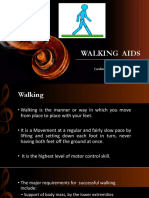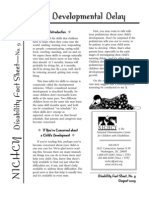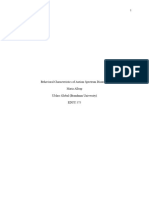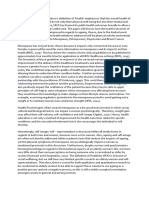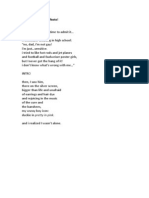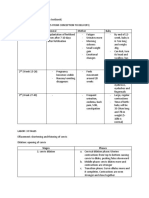Section One - About Disability: Sensory: Neurological: Physical
Section One - About Disability: Sensory: Neurological: Physical
Uploaded by
venkata ramakrishnaiahCopyright:
Available Formats
Section One - About Disability: Sensory: Neurological: Physical
Section One - About Disability: Sensory: Neurological: Physical
Uploaded by
venkata ramakrishnaiahOriginal Description:
Original Title
Copyright
Available Formats
Share this document
Did you find this document useful?
Is this content inappropriate?
Copyright:
Available Formats
Section One - About Disability: Sensory: Neurological: Physical
Section One - About Disability: Sensory: Neurological: Physical
Uploaded by
venkata ramakrishnaiahCopyright:
Available Formats
Section One – About Disability
This section covers:
1. What is a disability?
2. Types of disability
3. Causes of disability
4. Impact of disability
5. Prevalence of disability in Western Australia
6. Future trends in disability
7. Resource list
It is strongly encouraged that Section One is always used in conjunction with
any other sections.
The accompanying resource for this section is a PowerPoint, to be used as
part of a workshop / presentation.
1. What is disability?
A disability is any continuing condition that restricts everyday activities.
Disabilities can affect a person’s capacity to communicate, interact with
others, learn and get about independently. Disability is usually permanent but
may be episodic (WA Disability Services Act 1993).
2. Types of disability
Disabilities can be:
Sensory: affecting vision and / or hearing.
Neurological: affecting a person’s ability to control their movements.
Physical: affecting mobility and/or a person's ability to use their
upper or lower body. These generally relate to the
musculoskeletal, circulatory, respiratory and nervous
systems.
Intellectual: these can include intellectual and developmental
disabilities which can relate to difficulties with thought
processes, learning, communicating, remembering
information and using it appropriately, making judgements
and problem solving.
Cognitive: affecting a person's thought processes, personality and
memory resulting, for example, from an injury to the brain.
Psychiatric: affecting a person’s emotions, thought processes and
behaviour.
Some disabilities, such as epilepsy, are hidden, while others, such as cerebral
palsy, may be visible.
Physical disabilities are the most common (73 per cent), followed by
intellectual/psychiatric (17 per cent) and sensory (10 per cent).
People may have more than one disability and may experience additional
disadvantages to adequate service provision due to factors such as being
from culturally and linguistically diverse backgrounds or because they live
outside the metropolitan area or outside a regional centre.
3. Causes of disability
The causes of disability vary. As a person ages the severity of the disability
can change.
Disabilities may be:
genetically determined;
environmentally determined; or
of unknown cause.
A genetically determined disability is usually inherited from the parents.
However, a new genetic error can occur leading to symptoms of the condition.
Examples of this are cystic fibrosis and muscular dystrophy.
An environmentally determined disability results from an accident, injury,
disease or infection. Examples include acquired brain injury, spinal cord injury
and diabetes.
Sometimes a disability is of unknown origin. This is the case with many
physical and intellectual disabilities.
Disabilities vary according to individual circumstances.
4. The impact of disability
While the degree and type of disability varies with individual circumstances,
people with disabilities frequently report that they experience difficulty being
independently mobile, or being able to see, hear, or communicate.
As a consequence, people with disabilities face barriers with everyday
activities such as hearing or understanding what is said, seeing small print,
climbing stairs or understanding signage.
The impact on the life of the person concerned can be major, particularly if the
individual has multiple disabilities. Often people with disabilities are unable to
do things most of us take for granted, such as:
reading and understanding public notices or newsletters;
accessing websites;
participating at the local swimming pool or recreation centre;
playing on the play equipment at the park;
hearing what is said at a public meeting; and
shopping at the local shops.
The exact impact of a disability on the life of an individual varies according to
a number of factors including:
the specific nature and severity of the disability;
the person’s strength, stamina, size, weight and age;
the person’s ability to cope; and
the physical, social and economic environment within which the person
is living.
Communities which are accessible and inclusive minimises the effect of
disability.
5. Prevalence of disability in WA
Disability affects one third of the Western Australian population.
The Australian Bureau of Statistics (ABS) estimates that there are 405,500
Western Australians that have reported to having a disability (20.6 per cent of
the total population).
An estimated 246,800 Western Australians are carers for people with
disabilities (12.6 per cent of the total population) (source ABS).
One in every 17 Western Australians aged 15 and over (91,600 people) has a
disability and is also a carer of a person with disabilities (source ABS).
Of the 405,500 Western Australians with disabilities, 115,800 people have
profound or severe core activity limitation (source ABS). Profound limitation
refers to when a person is unable to do, or always needs help or supervision
to carry out the functions of daily living. Severe limitation refers to when a
person sometimes needs help or supervision with daily living routines or has
difficulty understanding or being understood by family or friends or can
communicate more easily using non-spoken forms of communication.
Most people with disabilities experience some form of limitation or restriction
due to their disability.
The Commission’s website provides profiles on different regions in Western
Australia. The profiles give an estimate of the number of people with
disabilities for that area, as well as the number of the Commission service
users and the number of people receiving from Centrelink a Disability Support
Pension and / or Carer Allowance for their child(ren).
6. Future trends in disability
The number of Western Australians with disabilities is increasing. The ABS
conducts regular surveys on disability to report the extent of disability in
Australia, the need for support and the adequacy of support, and the
contribution of informal care.
The 2003 Survey of Disability, Ageing and Carers figures for prevalence of
disability show an increase since 1998 of 50,000 in the number of Western
Australians with a disability.
Between 2006 and 2026 the number of people with disabilities in Western
Australia is expected to increase by more than 210,000. This increase is
mainly due to our ageing population. People may have a disability at any age,
but the likelihood of having a disability increases as people get older. ABS
data indicates that 51 per cent of Western Australians over 60 years of age
have a disability. The number of older Western Australians with disabilities will
increase substantially as the ‘baby boomers’ move into age groups in which
disability is more prevalent. It is expected that there will be an overall
increase of 115.7 per cent over the next 20 years.
7. Resources
Profile of disability in Western Australia – www.disability.wa.gov.au
WA Disability Services Act 1993
Oral histories - by people in the disability field on their experiences with
disability in Western Australia. Housed at the Battye Library.
Lost Generations project - short films capturing the essence of individuals with
disabilities. (Available through the Commission’s Accommodation Directorate)
Australian Bureau of Statistics - www.abs.gov.au
You might also like
- Alexander Luria - Restoration of Function After Brain Injury-Pergamon Press (1963) PDFDocument300 pagesAlexander Luria - Restoration of Function After Brain Injury-Pergamon Press (1963) PDFDebarshi D100% (1)
- Assignment One Human DevelopmentDocument6 pagesAssignment One Human DevelopmentjenNo ratings yet
- Basic Human Body Measurements For Technological Design - ISO7250Document60 pagesBasic Human Body Measurements For Technological Design - ISO7250Julio López100% (1)
- Youlia Weber - Trauma 101 For Educators - Eduu 602Document6 pagesYoulia Weber - Trauma 101 For Educators - Eduu 602api-542152634No ratings yet
- CaseStudy 3 PaperDocument9 pagesCaseStudy 3 Paperarhodes777No ratings yet
- Fs AutismDocument4 pagesFs AutismSuzana NikolovskaNo ratings yet
- Pelvic TiltingDocument28 pagesPelvic Tiltingvenkata ramakrishnaiahNo ratings yet
- Walkingaids 180118043224Document74 pagesWalkingaids 180118043224venkata ramakrishnaiahNo ratings yet
- Farrier ToolsDocument19 pagesFarrier Toolsapi-306398192No ratings yet
- LMCC and Osce-Zu HuaDocument270 pagesLMCC and Osce-Zu HuaBurton Mohan100% (6)
- Product Manual 37710 (Revision K) : EG-3C and EG-R ActuatorsDocument40 pagesProduct Manual 37710 (Revision K) : EG-3C and EG-R Actuatorsmatt ridwan100% (1)
- Maxines - SU TS Training TS Wks 5-8Document2 pagesMaxines - SU TS Training TS Wks 5-8Steve PopelyNo ratings yet
- Karen Garner: Loveland Police Department Blue Team ReportDocument9 pagesKaren Garner: Loveland Police Department Blue Team ReportMichael_Roberts2019No ratings yet
- AdolescenceDocument9 pagesAdolescenceSwÏng Talunay TabordaNo ratings yet
- Child Safeguarding PolicyDocument21 pagesChild Safeguarding PolicymanagerNo ratings yet
- Early Childhood Development Policy ReviewDocument41 pagesEarly Childhood Development Policy ReviewalfonseoNo ratings yet
- Question 1 (A) A Disability Is Any Condition of The Body or Mind (Impairment) That Makes It More Difficult ForDocument13 pagesQuestion 1 (A) A Disability Is Any Condition of The Body or Mind (Impairment) That Makes It More Difficult ForMitala RogersNo ratings yet
- Deaf Blindness Traumatic Brain InjuryDocument46 pagesDeaf Blindness Traumatic Brain Injuryvirgilio paglingayenNo ratings yet
- Importance of Social InteractionsDocument2 pagesImportance of Social InteractionsbubblymunirNo ratings yet
- Ecological HandoutDocument4 pagesEcological HandoutDudi de JurasNo ratings yet
- Children and Death: Dr. Chua 07/25/2013 Group 6 - Witwew!Document6 pagesChildren and Death: Dr. Chua 07/25/2013 Group 6 - Witwew!Doc Prince CaballeroNo ratings yet
- Developmental Delay Fact SheetDocument4 pagesDevelopmental Delay Fact SheetNational Dissemination Center for Children with DisabilitiesNo ratings yet
- Sexual HealthDocument11 pagesSexual Healthapi-236516264No ratings yet
- Chapter 13 Prosocial Behaviour PDFDocument4 pagesChapter 13 Prosocial Behaviour PDFHeraNo ratings yet
- Physical Development in AdolescenceDocument13 pagesPhysical Development in AdolescenceKeren YeeNo ratings yet
- Setting ObservationDocument6 pagesSetting Observationapi-456995798No ratings yet
- Down Syndrome BrochureDocument2 pagesDown Syndrome Brochureapi-239652707No ratings yet
- DeafblindDocument30 pagesDeafblindRinhluiNo ratings yet
- TR A1 - A Critical Analysis FinalDocument10 pagesTR A1 - A Critical Analysis FinalPani StrachNo ratings yet
- Introducing... Your Mentor Family!: LEND Eco-Mapping AssignmentDocument2 pagesIntroducing... Your Mentor Family!: LEND Eco-Mapping AssignmentDiana DizonNo ratings yet
- Special Education IsDocument3 pagesSpecial Education Isapi-316642445100% (1)
- What Is Autism Spectrum Disorder?Document17 pagesWhat Is Autism Spectrum Disorder?Mark HibionadaNo ratings yet
- Arranging The Physical Environment of The Classroom To Support Teaching-LearningDocument5 pagesArranging The Physical Environment of The Classroom To Support Teaching-LearningMarwan Al-tayarNo ratings yet
- Autism Spectrum DisorderDocument22 pagesAutism Spectrum Disorderrupal aroraNo ratings yet
- Group 6 FUNCTION-OF-PLAYDocument2 pagesGroup 6 FUNCTION-OF-PLAYJhaga PotpotNo ratings yet
- Advocacy Plan FinalDocument14 pagesAdvocacy Plan Finalapi-583336226No ratings yet
- Families and Teachers: Partners in Education Families and Teachers: Partners in EducationDocument46 pagesFamilies and Teachers: Partners in Education Families and Teachers: Partners in EducationMaeven E. TubayanNo ratings yet
- Traumatic Brain Injury: What's Inside?Document6 pagesTraumatic Brain Injury: What's Inside?api-312955728100% (1)
- Adolescent Development: Physical and Emotional DevelopmentDocument14 pagesAdolescent Development: Physical and Emotional DevelopmentAoi Sora100% (1)
- Theory PaperDocument16 pagesTheory Paperapi-531236909100% (1)
- Developmentally Appropriate Play Professional DevelopmentDocument35 pagesDevelopmentally Appropriate Play Professional Developmentapi-550630285No ratings yet
- Conceptual Models of Child Malnutrition The ACF Approach in Mental Health and Care Practices 01.2013Document76 pagesConceptual Models of Child Malnutrition The ACF Approach in Mental Health and Care Practices 01.2013yayuk dwi n100% (1)
- Hormone Sgoona Roller Coaster Ride in Adolesce NCEDocument65 pagesHormone Sgoona Roller Coaster Ride in Adolesce NCESunetra Mondal100% (1)
- Egocentrism - WikipediaDocument8 pagesEgocentrism - WikipediaDiana GhiusNo ratings yet
- Cerebral PalsyDocument7 pagesCerebral Palsyapi-315294234No ratings yet
- The Determinants of HealthDocument1 pageThe Determinants of HealthMac MacapilNo ratings yet
- Child and Adolescent1Document14 pagesChild and Adolescent1ShayneEchemaneNo ratings yet
- Behavioral Characteristics of Asd Paper - Allsup MariaDocument5 pagesBehavioral Characteristics of Asd Paper - Allsup Mariaapi-739355285No ratings yet
- Working With Families in An Ece Setting Educ 91 2014course OutlineDocument4 pagesWorking With Families in An Ece Setting Educ 91 2014course Outlineapi-283974231No ratings yet
- Evidence-Based Review of Interventions For Autism Used in or of Relevance To Occupational TherapyDocument14 pagesEvidence-Based Review of Interventions For Autism Used in or of Relevance To Occupational TherapyGabriela LalaNo ratings yet
- Supporting People With Sensory Loss Guide For Social Service Professionals EnglishDocument12 pagesSupporting People With Sensory Loss Guide For Social Service Professionals EnglishLiza GomezNo ratings yet
- ReflectionDocument9 pagesReflectionAAG2No ratings yet
- Human Growth and Development YAHOODocument53 pagesHuman Growth and Development YAHOOMay BañezNo ratings yet
- Brofenbrenner Report 9Document17 pagesBrofenbrenner Report 9Dhazel Joy JanitoNo ratings yet
- Rehabilitation Counselling Assignment Early Intervention by Sheila MirandaDocument6 pagesRehabilitation Counselling Assignment Early Intervention by Sheila Mirandaadheena simonNo ratings yet
- Authentic AssessmentDocument7 pagesAuthentic Assessmentapi-331383409No ratings yet
- Kroneman CapstoneDocument22 pagesKroneman Capstoneapi-504044748No ratings yet
- Supporting Children With EBSD Feb 2010Document14 pagesSupporting Children With EBSD Feb 2010Floares MagdaNo ratings yet
- Disabilites NotebookDocument5 pagesDisabilites Notebookapi-649553832100% (1)
- Personal PhilosophyDocument2 pagesPersonal Philosophyapi-388784385100% (1)
- Essay About HealthDocument4 pagesEssay About HealthCanNo ratings yet
- Early InterventionDocument12 pagesEarly InterventionNasreen FatimaNo ratings yet
- 4as To Rise Above Moral Distress PDFDocument14 pages4as To Rise Above Moral Distress PDFOscar PerezNo ratings yet
- Cross Disability Early Intervention Centres: Inauguration ofDocument12 pagesCross Disability Early Intervention Centres: Inauguration ofSumit ShahiNo ratings yet
- Research Supporting DIRDocument6 pagesResearch Supporting DIRsegurryNo ratings yet
- Physical Impairment, Disability, and ADHD: Irfan IftekharDocument26 pagesPhysical Impairment, Disability, and ADHD: Irfan IftekharIrfan IftekharNo ratings yet
- ECED (Bandura's Theory)Document30 pagesECED (Bandura's Theory)dawnella rimarim100% (1)
- Well-Child Care in Infancy: Promoting Readiness for LifeFrom EverandWell-Child Care in Infancy: Promoting Readiness for LifeNo ratings yet
- Hospital Management - Training and Professional DevelopmentDocument46 pagesHospital Management - Training and Professional Developmentvenkata ramakrishnaiahNo ratings yet
- Occupational Therapy For Spinal Cord Injury PatientsDocument8 pagesOccupational Therapy For Spinal Cord Injury Patientsvenkata ramakrishnaiahNo ratings yet
- Hansen's Disease (Leprosy) : Dr. Venkata Ramaiah.V MPT OrthoDocument72 pagesHansen's Disease (Leprosy) : Dr. Venkata Ramaiah.V MPT Orthovenkata ramakrishnaiahNo ratings yet
- Peripheral Nerve Injury in Upper LimbDocument29 pagesPeripheral Nerve Injury in Upper Limbvenkata ramakrishnaiahNo ratings yet
- Behavioral & Learning Problems in The Disabled: DR Venkata Ramaiah ValluriDocument29 pagesBehavioral & Learning Problems in The Disabled: DR Venkata Ramaiah Vallurivenkata ramakrishnaiahNo ratings yet
- Adhi Lakshmi (MMT)Document35 pagesAdhi Lakshmi (MMT)venkata ramakrishnaiah100% (1)
- Muscle Re-Education by Venkata RamaiahDocument8 pagesMuscle Re-Education by Venkata Ramaiahvenkata ramakrishnaiahNo ratings yet
- Physiotherapy in Autism ManagementDocument5 pagesPhysiotherapy in Autism Managementvenkata ramakrishnaiah100% (1)
- Sensory IntegrationDocument14 pagesSensory Integrationvenkata ramakrishnaiahNo ratings yet
- Isometric Exercise (Static Exercise)Document18 pagesIsometric Exercise (Static Exercise)venkata ramakrishnaiah100% (3)
- Medical Case Sheet: Ayushman Bharat Niramayam' Madhya PradeshDocument11 pagesMedical Case Sheet: Ayushman Bharat Niramayam' Madhya Pradeshvenkata ramakrishnaiahNo ratings yet
- Introduction To NeurophysiologyDocument13 pagesIntroduction To Neurophysiologyvenkata ramakrishnaiah100% (2)
- Resisted Ex'sDocument109 pagesResisted Ex'svenkata ramakrishnaiahNo ratings yet
- Uw Health Job Description: Transplant Coordinator Job SummaryDocument4 pagesUw Health Job Description: Transplant Coordinator Job Summaryvenkata ramakrishnaiahNo ratings yet
- Determinants RESISTED EX'SDocument24 pagesDeterminants RESISTED EX'Svenkata ramakrishnaiahNo ratings yet
- PNF Techniques by RamDocument52 pagesPNF Techniques by Ramvenkata ramakrishnaiah100% (1)
- Barriers For The Using of Information Systems in Hospitals: A Qualitative StudyDocument6 pagesBarriers For The Using of Information Systems in Hospitals: A Qualitative Studyvenkata ramakrishnaiahNo ratings yet
- Barriers in The Implementa-Tion of Health Information Systems: A Scoping ReviewDocument18 pagesBarriers in The Implementa-Tion of Health Information Systems: A Scoping Reviewvenkata ramakrishnaiahNo ratings yet
- Co-Ordination: Prepared by Ahmed Shawky AliDocument59 pagesCo-Ordination: Prepared by Ahmed Shawky Alivenkata ramakrishnaiahNo ratings yet
- Proprioceptive Neuromuscular FacilitationDocument69 pagesProprioceptive Neuromuscular Facilitationvenkata ramakrishnaiah100% (1)
- 2 Amputation ExplainedDocument16 pages2 Amputation Explainedvenkata ramakrishnaiahNo ratings yet
- Suspension Therapy by Rahul Vapms CopDocument20 pagesSuspension Therapy by Rahul Vapms Copvenkata ramakrishnaiahNo ratings yet
- Physiotherapy Affiliated Colleges List - Under NtruhsDocument3 pagesPhysiotherapy Affiliated Colleges List - Under Ntruhsvenkata ramakrishnaiah100% (2)
- Lead TimeDocument82 pagesLead Timevenkata ramakrishnaiahNo ratings yet
- Adhi Lakshmi (MMT)Document35 pagesAdhi Lakshmi (MMT)venkata ramakrishnaiah100% (1)
- Tendon Transfers: by DR Krishna BhattDocument89 pagesTendon Transfers: by DR Krishna Bhattvenkata ramakrishnaiahNo ratings yet
- Ambulation Aids and Patterns 2018Document59 pagesAmbulation Aids and Patterns 2018venkata ramakrishnaiah100% (1)
- Definition of Aquatic ExerciseDocument3 pagesDefinition of Aquatic Exercisevenkata ramakrishnaiah100% (1)
- Affidavit Complaint Slight Physical InjuryDocument2 pagesAffidavit Complaint Slight Physical Injuryduanepo100% (4)
- RULA Smart FormDocument1 pageRULA Smart FormJesus CentenoNo ratings yet
- 975 - ComboRollGroover - LR PDFDocument490 pages975 - ComboRollGroover - LR PDFarmagan55100% (1)
- Foodi XL Ad350coDocument11 pagesFoodi XL Ad350coJorge Ricardo RodriguezNo ratings yet
- Kls Martin Instrumenter Til HaandkirurgiDocument32 pagesKls Martin Instrumenter Til HaandkirurgiAmeer KhanNo ratings yet
- Your Grief - You Are Not Going CrazyDocument26 pagesYour Grief - You Are Not Going Crazyminiicecube100% (2)
- Hand Burns: Karen J. Kowalske, MD, David G. Greenhalgh, MD, Scott R. Ward, PHD, PTDocument4 pagesHand Burns: Karen J. Kowalske, MD, David G. Greenhalgh, MD, Scott R. Ward, PHD, PTalizzxNo ratings yet
- Pathology of Hemodynamic Disorders 1 and 2 Practice Questions-1Document26 pagesPathology of Hemodynamic Disorders 1 and 2 Practice Questions-1JCNo ratings yet
- Seria Rune SwordsDocument4 pagesSeria Rune SwordsSoare SabinaNo ratings yet
- G.R. No. L-25499 Villa Rey Vs CADocument4 pagesG.R. No. L-25499 Villa Rey Vs CAClarissa SawaliNo ratings yet
- The Wussy Boy Manifesto!Document11 pagesThe Wussy Boy Manifesto!Nicolas ThorpeNo ratings yet
- Igni 3Document219 pagesIgni 3pinkyzxNo ratings yet
- VSR 511Document26 pagesVSR 511DrHemant PanchalNo ratings yet
- OMM Practical 1Document4 pagesOMM Practical 1joe doweNo ratings yet
- Medical MnemonicsDocument140 pagesMedical Mnemonicsmir-medicina100% (2)
- Wilderness First Aid 680-008 PDFDocument43 pagesWilderness First Aid 680-008 PDFScott Kramer100% (1)
- Examination of The Joints and ExtremitiesDocument66 pagesExamination of The Joints and Extremitiesapi-25914483No ratings yet
- Williamhillus - Super Bowl 53 Prop Packet - Nevada - 012419 PDFDocument14 pagesWilliamhillus - Super Bowl 53 Prop Packet - Nevada - 012419 PDFAsbury Park PressNo ratings yet
- Autopsy Report of Phoenix RiverDocument17 pagesAutopsy Report of Phoenix RiverAnn MirNo ratings yet
- The Pathophysiology of SpasticityDocument18 pagesThe Pathophysiology of SpasticityjpwchardonNo ratings yet
- Progress Test 4Document5 pagesProgress Test 4Marcin Piechota100% (1)
- JoustComplete PDFDocument37 pagesJoustComplete PDFIan Pillay100% (2)
- PREGNANCYDocument4 pagesPREGNANCYShaileeNo ratings yet







